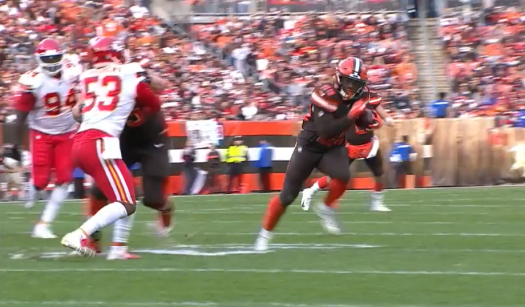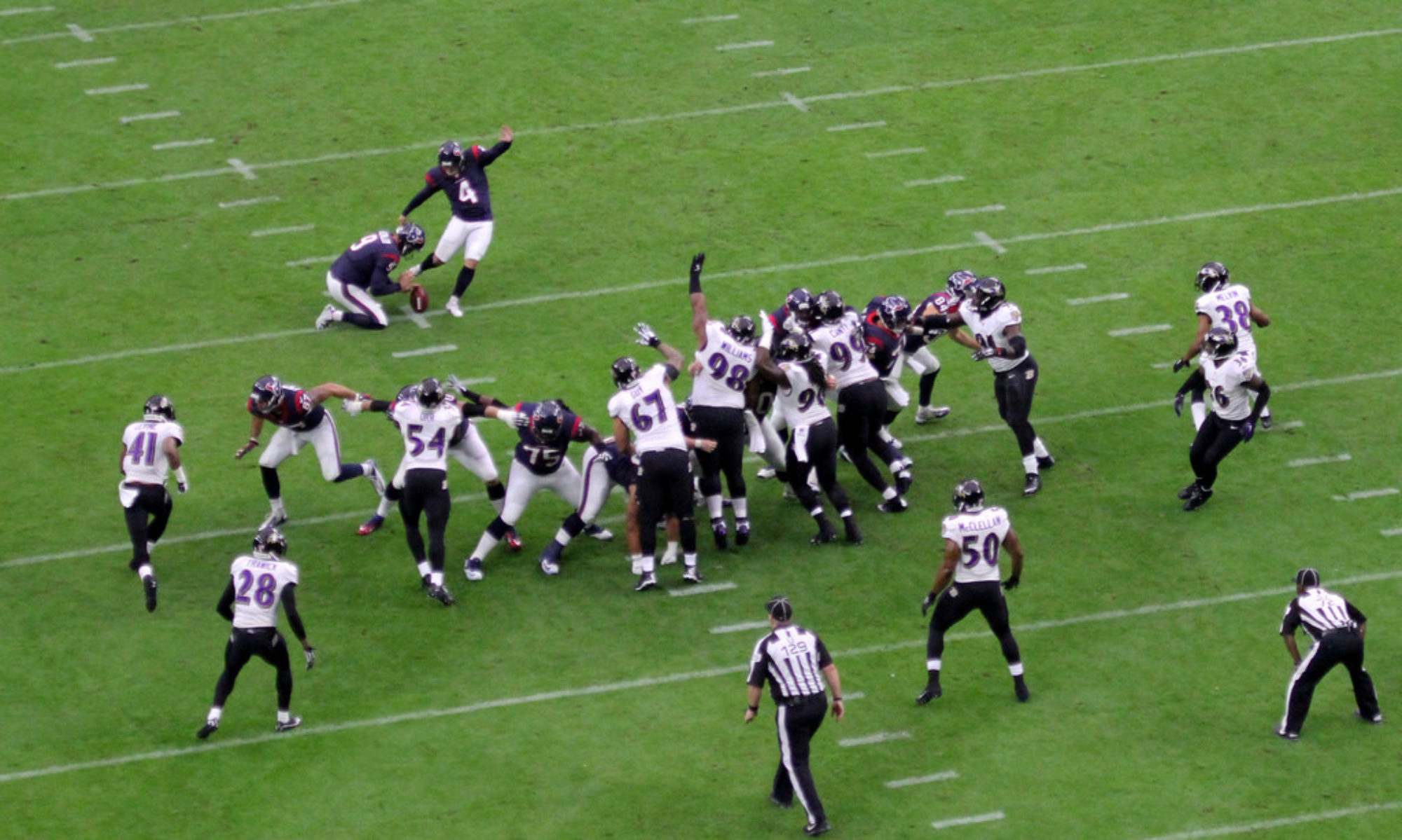
I’ve been an unabashed supporter of the idea of picking up a real receiving threat at running back for some time. Houston had brief flirtations with players like Andre Ellington, but never filled the role, instead having Lamar Miller as a pseudo-three-down back while Alfred Blue played a series here or there.
One of the most obvious of obvious fits here was Duke Johnson. The Texans had cap space to absorb his fairly sizable contract (for a running back), and Johnson was disgruntled with Cleveland and their move to pick up Kareem Hunt.
I’m a huge fan of the player. I’m not as huge of a fan of the price. Let’s talk about what Johnson can offer to the team first.
On a pure X’s and O’s level, Johnson gives the Texans a legitimate threat to catch the ball when they go empty with Deshaun Watson, which is one of Watson’s favorite ways to play:
Johnson has the speed and skill to emulate what Arian Foster did for the Texans in 2014 and 2015, as the only receiver to ever catch more than 2.5 balls a game under O’Brien. Johnson, I would argue, is more explosive with the ball in his hands in space than Foster is. He’s also a more natural receiver of the ball. That doesn’t mean we can’t learn from how the Texans deployed Foster.
Foster had a stretch from Weeks 5-7 in 2015 where he averaged over seven receptions per game. It ended only because he tore his Achilles in a nothing play at the end of a rainy day in Miami. (I always thought it was poetic that he hurt himself there and that he played for Miami given his first coming out party was against the Dolphins in 2009.) At the time, Houston’s non-Hopkins receivers were Nate Washington, Cecil Shorts III, and Keith Mumphery. It was a target void waiting to be filled, and Foster was the easy offense.
Foster was able to exploit mismatches against slower linebackers, and it gave the Texans an edge that they couldn’t find outside or in the slot. What I think Texans fans should be excited about is that Watson’s ability to loft the ball is one of his finest skills, and I think he’ll be able to guide Duke Johnson to space fairly easily:
In a best-case world, Johnson is a difference maker for an offense that focuses on how he, DeAndre Hopkins, and Will Fuller are so difficult to completely cover at the same time. He spreads the defense out further, he’s effective running out of shotgun, and he’s got terrific tackle-breaking ability. Per Sports Info Solutions, Johnson broke 20 tackles in just 87 touches last season. Lamar Miller had 27 in more-than-double the touch amount. If the Texans commit to Johnson as more of an every-down back when the game is close and leave the ground-and-pound for running out the clock, they’ve got the makings of a dynamic offense.
But, what is a more realistic approximation of what will happen? And why was that price so high?
Let’s assume that the Texans continue to start Lamar Miller because of seniority and he is still the main back on first- and second-down as long as Houston isn’t in comeback mode. You have cut how impactful Johnson can be.
O’Brien’s offense rarely throws to running backs. It bottomed out at 67 targets last year, and has been as high as 114 in 2015 when Foster briefly ran the show. But the context of those Foster targets is that the team had no other real receiving threats. Only three Texans on the entire roster hit more than 300 receiving yards that year, and the highest non-Hopkins player was Washington at 658. What the Texans are looking at currently is Hopkins, Will Fuller, Keke Coutee (if healthy), and a burgeoning collection of young tight ends. They’ve got a lot of mouths to feed. I find it a lot harder to believe that Johnson is going to be utilized like Foster was simply because the surrounding talent should keep O’Brien from trying to solve a problem.
We also have to take into account the rest of the context of this move:
— The Texans got caught with their pants down when they released D’Onta Foreman. To have no experienced depth on hand is a sign of poor risk management. Even if they thought Foreman was a “hard worker” coming into the camp (whatever that means) and liked his personality there, they should have been concerned in advance about his Achilles recovery and made a backup back a real priority. The “need” that the Texans had for a back was caused by cascade move after cascade move of poor roster management. And I think you all know who is likely to blame for this, because this team currently has no general manager!
— I think Johnson’s a great player, but I don’t think he’s a versatile enough to deliver what O’Brien is going to want from him if they run him in base sets with Watson under center. Johnson is going to come in through most of the bonding of camp and be forced into learning a new playbook, new landmarks with new teammates, and have to deliver on the fly. What happens if he fumbles twice in his first four games? You can’t really bench Johnson, but it would make total sense that he’d be more mistake-prone early on in the season.
— You can find 70-to-80 percent of Duke Johnson’s most impressive skill on the free-agent market for pennies on the dollar. Part of the reason I advocated trading for him is that I thought the Browns would be so fed up that they’d be willing to take a lower-round pick than he was worth. Ty Montgomery was a one-year deal. Darren Sproles was hanging around all offseason. Corey Grant. Jacquizz Rodgers. Theo Riddick was available for free last week. It’s not hard to find an NFL back that can do most of what Johnson does. You use that as leverage.
Instead, the Texans gave up what will likely be a third-round pick for Johnson (it will be a fourth-rounder if he gets hurt). That’s just a mind-boggling pick request and acceptance from Bill O’Brien. No back has gone for more than that on the trade market since Trent Richardson. I’m not a Running Backs Don’t Matter guy, but you have to have your head buried in the sand to not understand that backs are devalued and that you don’t have to pay market value for them.
When expressing this opinion on internet hellscape Twitter, I was immediately assailed by Texans fans that the Texans have compensation picks and aren’t good at mid-round drafting anyway, and also they had a glaring need. Well, here are my rebuttals:
1) That doesn’t devalue the third-round pick for everyone else,
2) If your talent evaluator can’t hit a third-round pick, one of the main building blocks of an NFL roster today, why is he still employed?
3) Might be a good idea to not get mad at your backup running back and release him before you give up all of your trade leverage!
Where I’m at on this trade is that the best-case scenarios of it happen in Houston’s worst-case scenarios. If Johnson gets hurt and they get to keep the third, that’s beneficial. If other players get hurt and O’Brien has to build an offense around Johnson, I can see it being beneficial. It raises the floor of the offense, and it raises the ceiling of the offense, but both of those rely on O’Brien finding the right way to use Johnson.
Without extraordinary revamping that we rarely see from O’Brien, I would be surprised if Johnson was targeted and used enough to provide value requisite to the third-round pick.
But his best plays are going to be fun as hell to watch.

One Reply to “Will Bill O’Brien’s plan for Duke Johnson be worth the price of admission?”